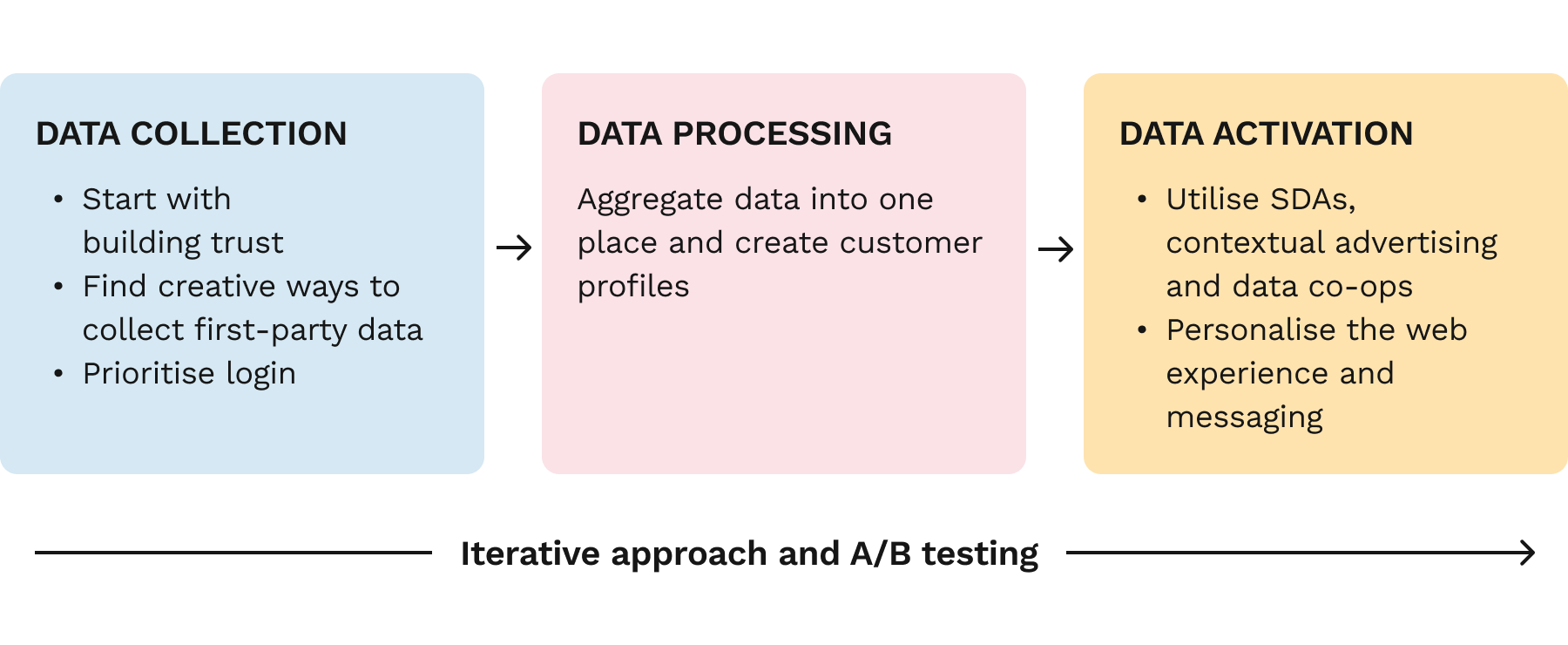Checklist for cookieless marketing
Get a head start on the cookieless future with this downloadable checklist!
The world of digital sales is about to change with the end of third-party cookies. The change forces marketers to rethink how they can reach the right audience digitally. While going cookieless might be a significant challenge, there remain vast opportunities for those who can collect, process and leverage first-party data creatively and efficiently. In our "Going cookieless" series, we explore each in depth.
In our last blog post, we explained the change happening in the digital sales and marketing realm with the death of third-party cookies. In this blog post, we’ll dive deep into the opportunities that lie in data collection.

As the access to third-party data is increasingly limited, marketers should find new ways to collect zero-party and first-party data. It all begins with building trust with your customers. When your customer trust you and you prove to be worthy of their trust, you can utilise creative ways to collect customer data. In addition, making it easy for customer to say hello to you in the form of login, is a winning tactic in the future of digital marketing.
Start with building trust
Trust should always be the foundation of digital business. It’s cultivated with every experience your customer has with your company – and it can be broken with any interaction.
According to Adobe, 58% of consumers state that they’ll stop purchasing from a brand that doesn’t provide a personal experience. At the same time, 72% of consumers say bad personalisation decreases their trust in brands. Customers expect experiences tailored to their needs and behaviours and use these experiences to build trust with brands.
Yet, customers are increasingly raising concerns about privacy. It’s up to businesses to strike a balance between catering to personal needs and making sure customers don’t feel uncomfortable about sharing personal data.
The key is allowing customers to control how their data is being used. This builds a relationship where customers see the value of their data, and trust is gained on both sides – the customer using the technology and the brand delivering personalised experiences.
Next, we’ll explore three ways to build trust in digital sales environments.
Build trust with UX and UI
Positive and consistent user experiences are key to cultivating trust. Do this by aligning language, layout, and colour scheme throughout the interface to give an impression of consistent quality and trustworthiness.
In practice, make sure your site offers seamless navigation and an intuitive interface. In terms of tone of voice, make sure you use simple and clear language that’s easy to understand. In other words, speak to your customer as a friend would. Finally, remember that first impressions matter. Create a positive first impression by avoiding visual clutter.
Build trust with transparency
When it comes to collecting customer data, make sure you’re transparent about the way you handle it. Highlight how you value security. Utilise reviews and endorsements as well as security and payment badges. Finally, make sure your customers can reach out to you if they are confused about anything by making contact information available.
Build trust by understanding your users
To cultivate trust, it’s crucial that you get to know your customers. Identify their goals, needs and motivations so you can serve them best. Customer journey mapping is a great way to get started with this. It also helps identify what data to collect at each stage of the customer journey.
Understand also the different needs and privacy concerns of different customers. For example, a user who just wants to buy a T-shirt might not feel comfortable logging in to your store but might still be fine with providing an email address. Once you understand your customers, you’ll be able to serve them best and cultivate trust to collect first-party data.
Prioritise login
By making login as easy as possible, companies can simultaneously improve customer experience and collect more relevant first-party data. Moreover, well-thought-out login capabilities help build authentic customer relationships by empowering the customer to choose what data they want to share for which purpose.
The key is to make it easy for customers to say hello. Authentication shouldn’t have to be complicated. Forget having to remember passwords, and utilise, for example, magic links from email, FaceID, one-time passwords in SMS, or entering pieces of information that are easy to remember, such as email and postal code.
And make sure you remember your customers. Don't automatically log customers out after a period of inactivity, but instead, keep them signed in.
Find creative ways to collect customer data
While login can be the most obvious way to collect first-party data, there are other possibilities as well. As you won’t be able to purchase third-party data, you’ll need to look for creative ways to collect zero-party and first-party data.
Provide your customers with true value in return for their willingness to share their personal data. In B2B, this could mean, for example, valuable insights that are gated behind a form. Successful lead magnets are a win-win situation for you and your customers. For planning great inbound content, you can utilise our Inbound content canvas.
You can also find ways to gain zero-party data, with, for example, quizzes, surveys or polls that can be used to understand your customers’ preferences and can further be leveraged with personalisation.
As an example, think of Fazer’s personalised chocolate bars. The service allows people to add a name or a personalised message on the chocolate bar wrapper. With the service, the company can understand who its customers are while providing them with a personalised brand experience that has the potential to cultivate trust and a sense of belonging.
As you’ve established creative and compliant ways to collect data about your customers, the next step is to process the data well. Our next blog post shares some of the best practices for data creation, analytics and processing.
Read other parts of the series:
The digital sales and marketing landscape is set to face a major challenge with the disappearance of third-party cookies. At Columbia Road, we see this as an opportunity for those who are ready to adapt and embrace change.
As a premium partner in digital commerce, we specialise in building seamless digital solutions and running concrete growth activities that help businesses sell better. Our cross-functional teams work hands-on and take ownership of your business goals. Data is in our DNA, and we always deliver results – even in the cookieless future of digital sales.
The Data Handbook
How to use data to improve your customer journey and get better business outcomes in digital sales. Interviews, use cases, and deep-dives.
Get the book




